by SaidHayani@
Learn Bootstrap 4 in 30 minutes by building a landing page website


A guide for beginners
“Bootstrap is a free, open-source front-end library for designing websites and web applications. It contains HTML- and CSS-based design templates for everything from typography, forms, buttons, navigation and other interface components as well as JavaScript extensions. Unlike many other web frameworks, Bootstrap concerns itself with front-end development only.” — Wikipedia
Hi, before we start check out my full class to learn Bootstrap 4 ,where you will learn new features of bootstrap and how to use them to build better user experiences .
There are many versions of Bootstrap with version 4 being the latest. In this article, we are going to build a website using Bootstrap 4.
Prerequisites
Before starting, there are some skills you’ll have to know in order to learn and use the Bootstrap framework:
- HTML fundamentals
- basic knowledge of CSS
- and some basic JQuery
Table of Contents
We will cover the topics below while building the website:
- Downloading and installing Bootstrap 4
- The new features of Bootstrap 4
- Bootstrap Grid system
- Navbar
- Header
- Buttons
- About Section
- Portfolio Section
- Blog Section
- Cards
- Team Section
- Contact Form
- Fonts
- Scroll Effect
- Wrap-up and Conclusion
Downloading and installing Bootstrap 4
There are three ways to install and include Bootstrap 4 for your project:
- Use npm
You can install Bootstrap 4 by running this command npm install bootstrap
2. Use a Content Delivery Network (CDN)
By including this link in your project between head tags:
<link rel="stylesheet" href="https://maxcdn.bootstrapcdn.com/bootstrap/4.0.0/css/bootstrap.min.css" integrity="sha384-Gn5384xqQ1aoWXA+058RXPxPg6fy4IWvTNh0E263XmFcJlSAwiGgFAW/dAiS6JXm" crossorigin="anonymous">3. Download the Bootstrap 4 library and use it locally.
The structure of our project should look like this:

The new features of Bootstrap 4
What’s new in Bootstrap 4? And what’s different between Bootstrap 3 and 4?
Bootstrap 4 now comes with some awesome features that didn’t exist in the last version:
- Bootstrap 4 is written using Flexbox Grid, whereas Bootstrap 3 was written using the float method.
If you’re new to Flexbox then check out this tutorial. - Bootstrap 4 uses
remCSS units whereas Bootstrap 3 usespx.
See how these two units differ. - Panels, thumbnails, and wells have been dropped entirely.
You can read in detail more about the global changes and removed features of Bootstrap 4 here.
Without jumping too deep into detail here, let’s move on to some other important things.
The Bootstrap Grid system
The Bootstrap Grid system helps you to create your layout and easily build a responsive website. There have not been any changes in the class names, except the .xs class, which no longer exists in Bootstrap 4.
The grid is divided into 12 columns, so your layout will be based on this.
To use the grid system you’ll have to add a .row class to the main div.
col-lg-2 // class used for large devices like laptops
col-md-2 // class used for medium devices like tablets
col-sm-2// class used for small devices like mobile phonesNavbar

The navbar wrapper is pretty cool in Bootstrap 4. It’s so helpful when it comes to building a responsive navbar.
To get it, we are going to add the navbar class to our index.html file:
<!-- navbar -->
<nav class="navbar navbar-expand-lg fixed-top ">
<a class="navbar-brand" href="#">Home</a>
<button class="navbar-toggler" type="button" data-toggle="collapse" data-target="#navbarSupportedContent" aria-controls="navbarSupportedContent" aria-expanded="false" aria-label="Toggle navigation">
<span class="navbar-toggler-icon"></span>
</button>
<div class="collapse navbar-collapse " id="navbarSupportedContent"> <ul class="navbar-nav mr-4">
<li class="nav-item">
<a class="nav-link" data-value="about" href="#">About</a> </li>
<li class="nav-item">
<a class="nav-link " data-value="portfolio"href="#">Portfolio</a>
</li>
<li class="nav-item">
<a class="nav-link " data-value="blog" href="#">Blog</a> </li>
<li class="nav-item">
<a class="nav-link " data-value="team" href="#"> Team</a> </li>
<li class="nav-item">
<a class="nav-link " data-value="contact" href="#">Contact</a> </li>
</ul>
</div></nav>Create and include a main.css file so that you can customize the CSS style.
Put this within the head tag in your index.html file:
<link rel="stylesheet" type="text/css" href="css/main.css">Let’s add some colors to our navbar:
.navbar{ background:#F97300;}
.nav-link , .navbar-brand{ color: #f4f4f4; cursor: pointer;}
.nav-link{ margin-right: 1em !important;}
.nav-link:hover{ background: #f4f4f4; color: #f97300; }
.navbar-collapse{ justify-content: flex-end;}
.navbar-toggler{ background:#fff !important;}The new Bootstrap Grid is built with the Flexbox system, so for alignment, you have to use a Flexbox property. For example, to place the navbar menu on the right we need to add a justify-content property and set it to flex-end.
.navbar-collapse{
justify-content: flex-end;
}Add the .fixed-top class to the navbar to give it a fixed position.
To make the navbar background color light, add .bg-light. For a dark background, add .bg-dark, and for a light blue background, add .bg-primary.
Here’s how that should look:
.bg-dark{
background-color:#343a40!important
}
.bg-primary{
background-color:#007bff!important
}Header
<header class="header">
</header>Let’s try and create a layout for the header.
Here, we want to make sure the header takes up the window’s height so we are going to use a little JQuery code.
First, create a file named main.js and include it in the index.html file before the closing body tag:
<script type="text/javascript" src='js/main.js'></script>In the main.js file insert this a little code of JQuery:
$(document).ready(function(){
$('.header').height($(window).height());
})It’d be pretty cool if we set a nice background image to the header:
/*header style*/
.header{
background-image: url('../images/headerback.jpg');
background-attachment: fixed;
background-size: cover;
background-position: center;
}
Let’s add an overlay to make the header look a bit more professional:
Add this to your index.html file:
<header class="header">
<div class="overlay"></div>
</header>Then, add this to your main.css file:
.overlay{
position: absolute;
min-height: 100%;
min-width: 100%;
left: 0;
top: 0;
background: rgba(244, 244, 244, 0.79);
}Now we have to add a description inside the header.
To wrap our description we’re first going to create a div and give it a class .container.
.container is a Bootstrap class that will help you to wrap your content and make your layout more responsive:
<header class="header">
<div class="overlay"></div>
<div class="container">
</div>
</header>Then, add another div which will contain the description.
<div class="description ">
<h1> Hello ,Welcome To My official Website
<p> cillum dolore eu fugiat nulla pariatur. Excepteur sint occaecat cupidatat non proident, sunt in culpa qui officia deserunt mollit anim id est laborum.
</p>
<button class="btn btn-outline-secondary btn-lg">See more</button> </h1>
</div>We’ll give it a class of .description and add the .text-center class to make sure the content is placed in the center of the page.
Buttons
Add the class .btn btn-outline-secondary to the button element. there are many other Bootstrap classes for buttons.
Check some examples:
CodePen Embed — buttons in Bootstrap 4
Buttons Button primary Button default Button danger Button info Button warning Button dark Button success Buttons…codepen.io
Here’s how the styling for the .description looks in the main.css file:
.description{
position: absolute;
top: 30%;
margin: auto;
padding: 2em;
}
.description h1{
color:#F97300 ;
}
.description p{
color:#666;
font-size: 20px;
width: 50%;
line-height: 1.5;
}
.description button{
border:1px solid #F97300;
background:#F97300;
color:#fff;
}After all of that, our header will look like this:
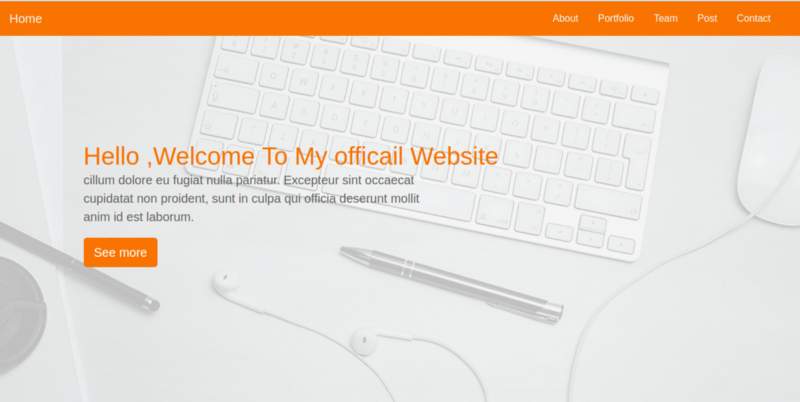
Cool isn’t :).
About Section

In this section, we will use some Bootstrap Grid to divide the section into two parts.
To start our grid, we have to assign the .row class to the parent div.
<div class="row"></div>The first section will be on the left and will contain a picture, the second section will be on the right and contain a description.
Each div will take up 6 columns — that means half of the section. Remember that a grid is divided into 12 columns.
In the first div on the left side:
<div class="row">
// left side
<div class="col-lg-4 col-md-4 col-sm-12">
<img src="images/team-3.jpg" class="img-fluid">
<span class="text-justify">S.Web Developer</span>
</div>
</div>After adding the the HTML elements on the right-side, the structure of the code will look like this:
<div class="row">
<div class="col-lg-4 col-md-4 col-sm-12">
<img src="images/team-3.jpg" class="img-fluid">
<span class="text-justify">S.Web Developer</span>
</div>
<div class="col-lg-8 col-md-8 col-sm-12 desc">
<h3>D.John</h3>
<p>
ipsum dolor sit amet, consectetur adipisicing elit, sed do eiusmod
tempor incididunt ut labore et dolore magna aliqua. Ut enim ad minim veniam,
quis nostrud exercitation ullamco laboris nisi ut aliquip ex ea commodo
consequat. Duis aute irure dolor in reprehenderit in voluptate velit esse
cillum dolore eu fugiat nulla pariatur. Excepteur sint occaecat cupidatat non
proident, sunt in culpa qui officia deserunt mollit anim id est laborum.
</p>
</div>
</div>Here’s how I’ve made it look:
.about{
margin: 4em 0;
padding: 1em;
position: relative;
}
.about h1{
color:#F97300;
margin: 2em;
}
.about img{
height: 100%;
width: 100%;
border-radius: 50%
}
.about span{
display: block;
color: #888;
position: absolute;
left: 115px;
}
.about .desc{
padding: 2em;
border-left:4px solid #10828C;
}
.about .desc h3{
color: #10828C;
}
.about .desc p{
line-height:2;
color:#888;
}Portfolio Section
Now, let’s move onto the next bit and make a portfolio section that will contain a gallery.
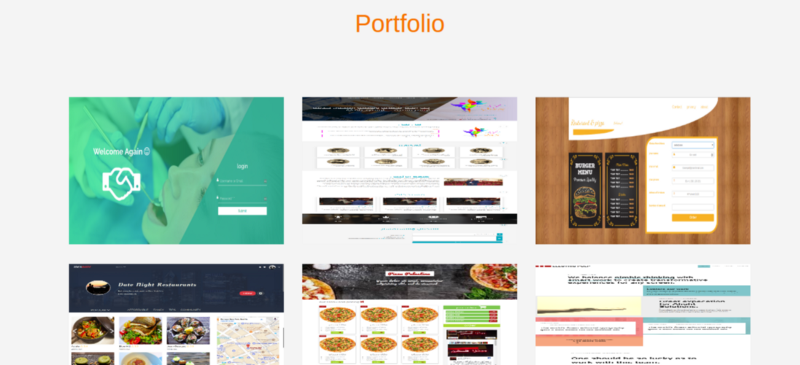
The structure of our HTML code for the Portfolio section looks like this:
<!-- portfolio -->
<div class="portfolio">
<h1 class="text-center">Portfolio</h1>
<div class="container">
<div class="row">
<div class="col-lg-4 col-md-4 col-sm-12">
<img src="images/portfolio/port13.png" class="img-fluid">
</div>
<div class="col-lg-4 col-md-4 col-sm-12">
<img src="images/portfolio/port1.png" class="img-fluid">
</div>
<div class="col-lg-4 col-md-4 col-sm-12">
<img src="images/portfolio/port6.png" class="img-fluid">
</div>
<div class="col-lg-4 col-md-4 col-sm-12">
<img src="images/portfolio/port3.png" class="img-fluid">
</div>
<div class="col-lg-4 col-md-4 col-sm-12">
<img src="images/portfolio/port11.png" class="img-fluid">
</div>
<div class="col-lg-4 col-md-4 col-sm-12">
<img src="images/portfolio/electric.png" class="img-fluid">
</div>
<div class="col-lg-4 col-md-4 col-sm-12">
<img src="images/portfolio/Classic.jpg" class="img-fluid">
</div>
<div class="col-lg-4 col-md-4 col-sm-12">
<img src="images/portfolio/port1.png" class="img-fluid">
</div>
<div class="col-lg-4 col-md-4 col-sm-12">
<img src="images/portfolio/port8.png" class="img-fluid">
</div>
</div>
</div>
</div>Adding .img-fluid to each image to makes it responsive.
Each item in our gallery will take up 4 columns (remember, col-md-4 for medium devices, col-lg-4 for large devices). That’s equal to 33.33333% on large devices such desktops and large tablets, and 12 columns on a small device (like iPhone, mobile devices) will take up 100% of the container.
Let’s add some styling to our Gallery:
/*Portfolio*/
.portfolio{
margin: 4em 0;
position: relative;
}
.portfolio h1{
color:#F97300;
margin: 2em;
}
.portfolio img{
height: 15rem;
width: 100%;
margin: 1em;
}Blog Section
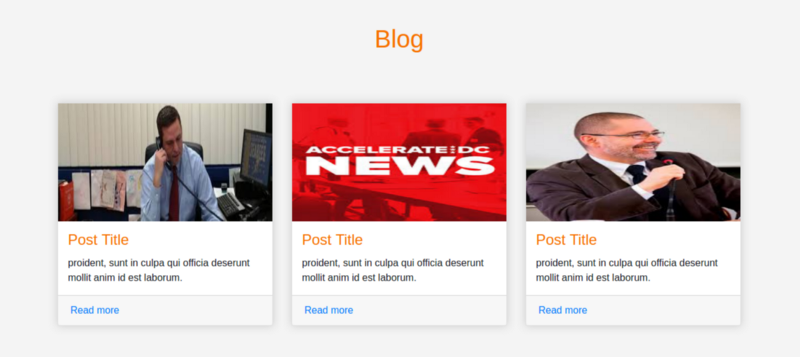
Cards
Cards in Bootstrap 4 make blog design so much easier. The cards are appropriate for articles and posts.
To create a card, we use the class .card and assign it to a div element,
The card class contains many features:
.card-header: define the card header.card-body: for the card body.card-title: the title of the cardcard-footer: define the footer of the card..card-image: for the card’s image
So, our website’s HTML should now look something like this:
<!-- Posts section -->
<div class="blog">
<div class="container">
<h1 class="text-center">Blog</h1>
<div class="row">
<div class="col-md-4 col-lg-4 col-sm-12">
<div class="card">
<div class="card-img">
<img src="images/posts/polit.jpg" class="img-fluid">
</div>
<div class="card-body">
<h4 class="card-title">Post Title</h4>
<p class="card-text">
proident, sunt in culpa qui officia deserunt mollit anim id est laborum.
</p>
</div>
<div class="card-footer">
<a href="" class="card-link">Read more</a>
</div>
</div>
</div>
<div class="col-md-4 col-lg-4 col-sm-12">
<div class="card">
<div class="card-img">
<img src="images/posts/images.jpg" class="img-fluid">
</div>
<div class="card-body">
<h4 class="card-title">Post Title</h4>
<p class="card-text">
proident, sunt in culpa qui officia deserunt mollit anim id est laborum.
</p>
</div>
<div class="card-footer">
<a href="" class="card-link">Read more</a>
</div>
</div>
</div>
<div class="col-md-4 col-lg-4 col-sm-12">
<div class="card">
<div class="card-img">
<img src="images/posts/imag2.jpg" class="img-fluid">
</div>
<div class="card-body">
<h4 class="card-title">Post Title</h4>
<p class="card-text">
proident, sunt in culpa qui officia deserunt mollit anim id est laborum.
</p>
</div>
<div class="card-footer">
<a href="" class="card-link">Read more</a>
</div>
</div>
</div>
</div>
</div>
</div>We need to add some CSS style to the cards:
.blog{
margin: 4em 0;
position: relative;
}
.blog h1{
color:#F97300;
margin: 2em;
}
.blog .card{
box-shadow: 0 0 20px #ccc;
}
.blog .card img{
width: 100%;
height: 12em;
}
.blog .card-title{
color:#F97300;
}
.blog .card-body{
padding: 1em;
}After adding the Blog section to our website, the design should now look something like this:
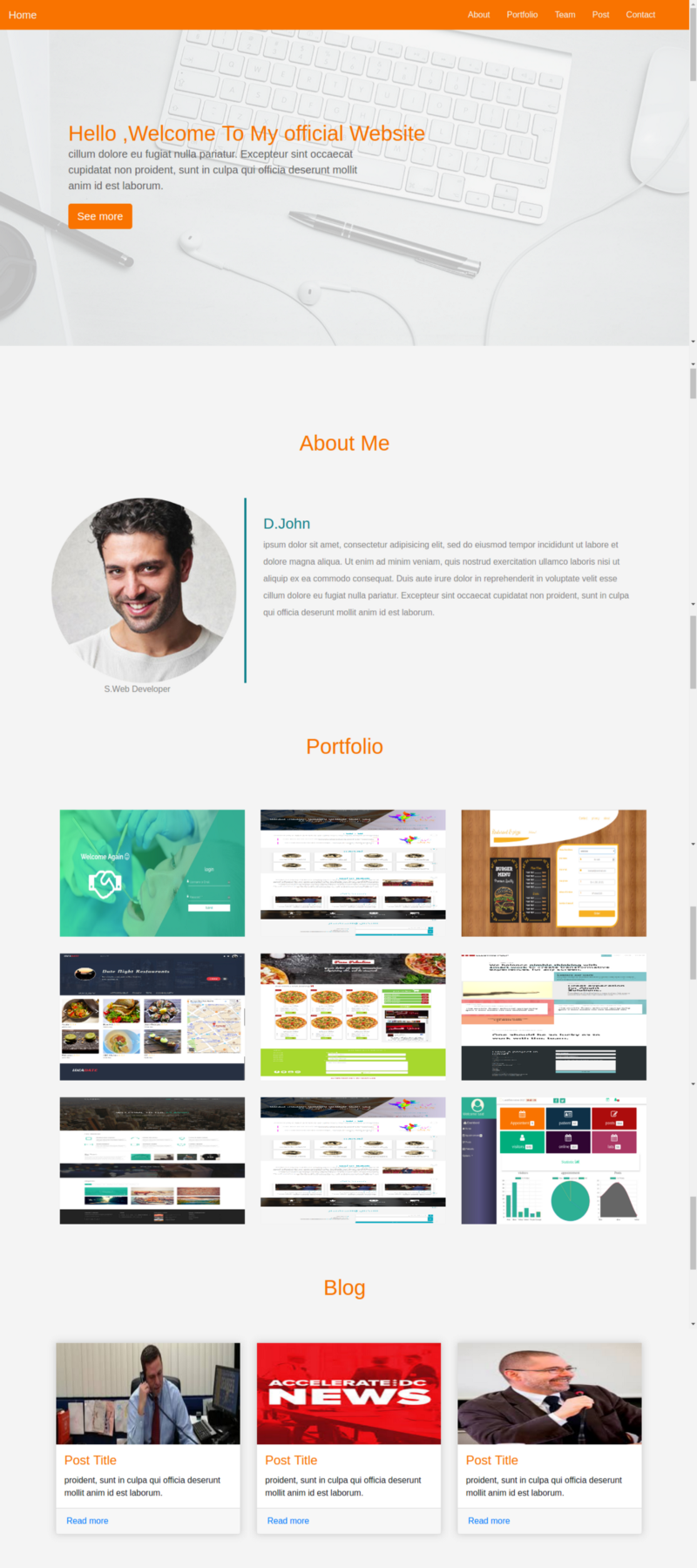
Cool isn’t it? ?
Team Section
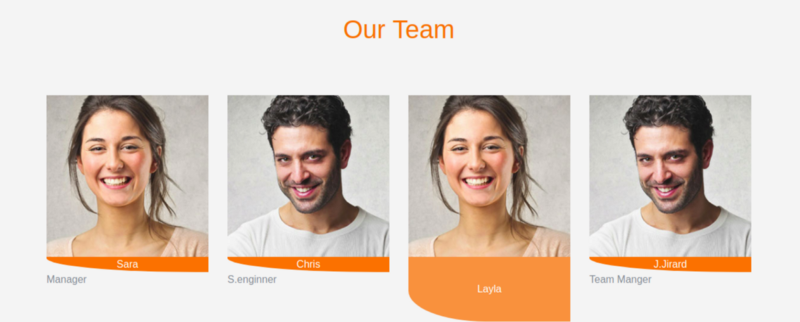
In this section we will use the grid system to distribute even space between images. Each image takes up 3 columns (.col-md-3) of the container — that equals 25% of the total space.
Our HTML structure:
<!-- Team section -->
<div class="team">
<div class="container">
<h1 class="text-center">Our Team</h1>
<div class="row">
<div class="col-lg-3 col-md-3 col-sm-12 item">
<img src="images/team-2.jpg" class="img-fluid" alt="team">
<div class="des">
Sara
</div>
<span class="text-muted">Manager</span>
</div>
<div class="col-lg-3 col-md-3 col-sm-12 item">
<img src="images/team-3.jpg" class="img-fluid" alt="team">
<div class="des">
Chris
</div>
<span class="text-muted">S.enginner</span>
</div>
<div class="col-lg-3 col-md-3 col-sm-12 item">
<img src="images/team-2.jpg" class="img-fluid" alt="team">
<div class="des">
Layla
</div>
<span class="text-muted">Front End Developer</span>
</div>
<div class="col-lg-3 col-md-3 col-sm-12 item">
<img src="images/team-3.jpg" class="img-fluid" alt="team">
<div class="des">
J.Jirard
</div>
<span class="text-muted">Team Manger</span>
</div>
</div>
</div>
</div>And let’s add some style:
.team{
margin: 4em 0;
position: relative;
}
.team h1{
color:#F97300;
margin: 2em;
}
.team .item{
position: relative;
}
.team .des{
background: #F97300;
color: #fff;
text-align: center;
border-bottom-left-radius: 93%;
transition:.3s ease-in-out;
}Adding an overlay to the image on-hover using animation would be nice ?.
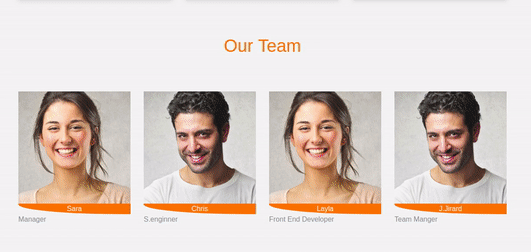
To make this effect , add the styles below to main.css file:
.team .item:hover .des{
height: 100%;
background:#f973007d;
position: absolute;
width: 89%;
padding: 5em;
top: 0;
border-bottom-left-radius: 0;
}Super cool! ?
Contact Form
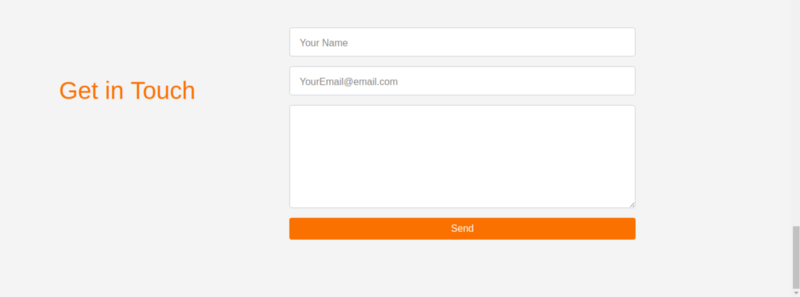
The Contact Form is the last section to add, then we are done ?.
The Contact Form section will contain a form through which visitors can send an email or give feedback. We will use some Bootstrap classes to make the design beautiful and responsive.
Like Bootstrap 3, Bootstrap 4 also uses the .form-control class for input fields, but there are some new features added — like switching from .input-group-addon (deprecated) to .input-group-prepend (to use icons as labels ).
See Bootstrap 4 document for more information. In our Contact form we will wrap each input between a div that has the class .form-group.
The index.html file now looks something like this:
<!-- Contact form -->
<div class="contact-form">
<div class="container">
<form>
<div class="row">
<div class="col-lg-4 col-md-4 col-sm-12">
<h1>Get in Touch</h1>
</div>
<div class="col-lg-8 col-md-8 col-sm-12 right">
<div class="form-group">
<input type="text" class="form-control form-control-lg" placeholder="Your Name" name="">
</div>
<div class="form-group">
<input type="email" class="form-control form-control-lg" placeholder="YourEmail@email.com" name="email">
</div>
<div class="form-group">
<textarea class="form-control form-control-lg">
</textarea>
</div>
<input type="submit" class="btn btn-secondary btn-block" value="Send" name="">
</div>
</div>
</form>
</div>
</div>Contact section’styles :
main.css
.contact-form{
margin: 6em 0;
position: relative;
}
.contact-form h1{
padding:2em 1px;
color: #F97300;
}
.contact-form .right{
max-width: 600px;
}
.contact-form .right .btn-secondary{
background: #F97300;
color: #fff;
border:0;
}
.contact-form .right .form-control::placeholder{
color: #888;
font-size: 16px;
}Fonts
I think default fonts are ugly so we are going to use the Google Font API, and we’ll choose Raleway which is a nice font and appropriate to our template.
Add this link into your main.css file:
@import url('https://fonts.googleapis.com/css?family=Raleway');and set the global style to HTML and heading tags:
html,h1,h2,h3,h4,h5,h6,a{
font-family: "Raleway";
}Scroll Effect

The last thing missing is scroll effect. Here, we’ll have to use some JQuery. Don’t worry️ if you are not familiar with it, just add this code into your main.js file:
$(".navbar a").click(function(){
$("body,html").animate({
scrollTop:$("#" + $(this).data('value')).offset().top
},1000)
})and add a data-value attribute to each navbar link:
<li class="nav-item">
<a class="nav-link" data-value="about" href="#">About</a>
</li>
<li class="nav-item">
<a class="nav-link " data-value="portfolio" href="#">Portfolio</a>
</li>
<li class="nav-item">
<a class="nav-link " data-value="blog" href="#">Blog</a>
</li>
<li class="nav-item">
<a class="nav-link " data-value="team" href="#">
Team</a>
</li>
<li class="nav-item">
<a class="nav-link " data-value="contact" href="#">Contact</a>
</li>Set an id attribute to each section.
Note: The id must be identical to the data-value attribute in the navbar link for the scroll to work:
<div class="about" id="about"></div>Wrap-up and Conclusion
Bootstrap 4 is a great option for building your web application. It delivers high quality of UI elements and it’s easy to customize, integrate and use. It will also help you to include responsiveness in your website, therefore delivering a premium user experience to your users.
You will find the project’s files on GitHub.
If you need some Bootstrap themes and templates you can check out BootstrapBay,they have some awesome products
Check out my Bootstrap Class to learn Bootstrap 4:
Bootstrap 4 crash course: basic to advance | Said Hayani | Skillshare
In this class the you are going to learn bootstrap version 4, the CSS framework to build flexible templates and…skl.sh